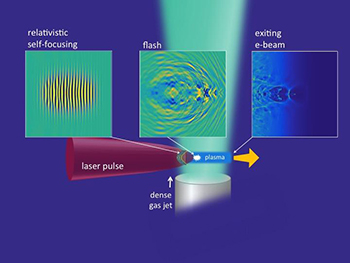
Low-energy laser pulses directed into a dense jet of hydrogen gas creates a beam of relativistic electrons that could enable portable ultrafast high-energy imaging devices for medical and research applications. Credit: Howard Milchberg / George Hine
Particle accelerators bring to mind huge supercolliders that take up miles of real estate to smash particles together for physics research. But another smaller class of particle accelerators exists for use in cancer therapy and condensed-matter physics research. These smaller machines require radiation shielding and large power supplies, which still take up a lot of space in a lab or clinic. Attempts to develop more compact sources of relativistic electrons have typically required expensive lasers with powers of 10 terawatts to a petawatt. But a new development may change that.
Researchers at the University of Maryland’s Institute for Research in Electronics and Applied Physics (College Park, Md., USA) have announced a breakthrough in electron acceleration that they suggest could enable truly portable particle accelerators for low-dose cancer therapy, medical imaging and isotope production (Phys. Rev. Lett., doi:10.1103/PhysRevLett.115.194802). The technology involves the use of record-low-energy ultrashort laser pulses to accelerate electrons in a hydrogen plasma to nearly the speed of light.
Howard Milchberg and colleagues focused 50-fs pulses with 10- to 50-mJ energies from a Ti:sapphire laser at 800 nm in wavelength into a thin, dense jet of cryogenically cooled hydrogen. The laser pulses drive a plasma wake in the jet, generating a relativistic electron beam with energies ranging from two to 12 MeV. Associated with teh electron beam are ultrashort flashes of light that contain as much as three percent of the initial pulse energy, which is much more efficient than previous studies produced. Furthermore, the technique uses only millijoules of energy, which is much less energy than previous studies required.
“This is the energy consumed by a typical household lightbulb in one-thousandth of a second,” said Milchberg. The approach, he says, paves the way for relatively inexpensive laser-driven particle accelerators that fit on a lab cart. The flash energy could also someday be used like a strobe light to image how electrons orbit atoms for the first time.
